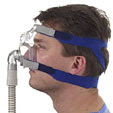
Continuous positive airway pressure (CPAP) therapy for obstructive sleep apnea
Continuous positive airway pressure therapy (CPAP) uses a machine to help a person who has obstructive sleep apnea (OSA) breathe more easily during sleep. A CPAP machine increases air pressure in your throat so that your airway does not collapse when you breathe in. When you use CPAP, your bed partner may sleep better, too.
You use CPAP at home every night while you sleep. The CPAP machine will have one of the following:
Important It is possible that the main title of the report Apnea, Sleep is not the name you expected. Please check the synonyms listing to find the alternate name(s) and disorder subdivision(s) covered by this report.
- A mask that covers your nose and mouth.
- A mask that covers your nose only-called nasal continuous positive airway pressure, or NCPAP (this type of mask is most common).
- Prongs that fit into your nose.
You may want to try similar machines that have automatically adjustable air pressure or air pressures that are different when you breathe in than when you breathe out.
What To Expect After Treatment
It may take time for you to become comfortable with using CPAP. If you cannot get used to it, talk to your doctor. You might be able to try another type of mask or make other adjustments.
Why It Is Done
CPAP is the most effective nonsurgical treatment for obstructive sleep apnea. It is the first treatment choice and the most widely used.
- Doctors use CPAP to treat people who have moderate to severe sleep apnea.
- CPAP is the treatment of choice for people who have sleep apnea and coronary artery disease (CAD) or heart failure.1
How Well It Works
Overall, CPAP is effective for moderate and severe obstructive sleep apnea:
- Research shows that continuous positive airway pressure (CPAP) decreases daytime sleepiness, especially in those with moderate to severe sleep apnea.2, 3But CPAP may not be as effective for people who have mild sleep apnea.3
- Studies show that in people who have moderate to severe sleep apnea, nasal continuous positive airway pressure (NCPAP) lowers blood pressure during both the day and the night.4, 5, 6
- CPAP is better than other non-surgical methods for treating obstructive sleep apnea.7
- People with coronary artery disease who use CPAP for sleep apnea are less likely to have heart problems such as heart failure.8
Risks
Problems that may occur with CPAP include:
- Nightmares and excessive dreaming during early use.
- Dry nose and sore throat.
- Nasal congestion, runny nose, and sneezing.
- Irritation of the eyes and the skin on the face.
- Abdominal bloating.
- Leaks around the mask because it does not fit properly.
Nosebleeds are a rare complication of CPAP.
You can expect mild discomfort in the morning when you first start using CPAP. Talk with your doctor if you do not feel comfortable after a few days.
Relieving side effects
You may be able to limit or stop some of the side effects:
- Your doctor may be able to adjust your CPAP to reduce or eliminate problems.
- Be sure the mask or nasal prongs fit you properly. Air should not leak around the mask.
- Use a humidifier or a corticosteroid nasal spray medicine to reduce nasal irritation and drainage.
- You may want to talk to your doctor about trying a CPAP machine that will start with a low air pressure and slowly increase the air pressure as you fall asleep. This kind of machine can help reduce discomfort caused by too much constant pressure in your nose. If this does not improve your discomfort, ask your doctor about trying a bilevel positive airway pressure machine (BiPAP), which uses a different air pressure when you breathe in than when you breathe out. BiPAP may work better than standard CPAP for treating obstructive sleep apnea in people who have heart failure.9 BiPAP machines are more expensive than CPAP machines.
- If your nose is runny or congested, talk with your doctor about using decongestants or corticosteroid nasal spray medicines.
What To Think About
When you are using CPAP, you need to see your doctor or sleep specialist regularly. You may also need more sleep studies to adjust the CPAP machine and check whether the treatment is working.
The machines are expensive. You may be able to rent a CPAP machine before you buy it. In some cases, you may be able to rent-to-own a CPAP machine.
The most common problem with CPAP is that people do not use the machine every night. Or they take off the mask during the night because it becomes uncomfortable. Even one night of not using the machine can make you sleepy the next day.
You might not use the machine daily, or you might even stop using it because:
- You don't like wearing a mask because of nasal discomfort.
- The machine is noisy.
- It may discourage intimacy with your sleeping partner, even though you use the machine only while you are sleeping.
The U.S. Food and Drug Administration (FDA) has approved some brands of portable CPAP machines. You may be able to take a smaller CPAP machine on vacations or other types of trips.
Complete the special treatment information form (PDF)(What is a PDFdocument?) to help you understand this treatment.
Citations
Silverberg DS, et al. (2002). Treating obstructive sleep apnea improves essential hypertension and quality of life. American Family Physician, 65(2): 229–236.
Giles TL, et al. (2006). Continuous positive airways pressure for obstructive sleep apnoea in adults. Cochrane Database of Systematic Reviews (3).
Hensley M, Ray C (2006). Sleep apnea. Clinical Evidence (15): 1–18.
Pepperell JC, et al. (2002). Ambulatory blood pressure after therapeutic and subtherapeutic nasal continuous positive airway pressure for obstructive sleep apnoea: A randomised study.Lancet, 359(9302): 204–210.
Becker HF, et al. (2003). Effect of nasal continuous positive airway pressure treatment on blood pressure in patients with obstructive sleep apnea. Circulation, 107(1): 68–73.
Norman D, et al. (2006). Effects of continuous positive airway pressure versus supplemental oxygen on 24-hour ambulatory blood pressure. Hypertension, 47(5): 840–845.
Lam B, et al. (2007). Randomised study of three non-surgical treatments in mild to moderate obstructive sleep apnoea.Thorax, 62(4): 354–359.
Milleron O, et al. (2004). Benefits of obstructive sleep apnoea treatment in coronary artery disease: A long-term follow-up study. European Heart Journal, 25(9): 728–734.
Khayat RN, et al. (2008). Cardiac effects of continuous and bilevel positive airway pressure for patients with heart failure and obstructive sleep apnea. Chest, 134(6): 1162–1168.
Author Maria Essig Editor Susan Van Houten, RN, BSN, MBA Associate Editor Pat Truman, MATC Primary Medical Reviewer E. Gregory Thompson, MD - Internal Medicine Specialist Medical Reviewer Mark A. Rasmus, MD - Pulmonary, Critical Care and Sleep Medicine Last Updated July 9, 2009





When having a dry nose while using your CPAP machine try using a nasal gel just like my doctor prescribed on me.
ReplyDelete